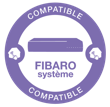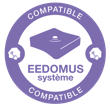



RGBW Controller 2 is a universal RGB / RGBW controller compatible with Z-Wave Plus.

Security guarantees

Shipping Policy




RGBW Controller 2 is a universal RGB / RGBW controller compatible with Z-Wave Plus. The FIBARO RGBW 2 controller uses the PWM output signal, which allows it to control LED, RGB, RGBW, halogen lights and other resistive loads. It can also measure active power and energy consumed by the load.
Controlled devices can be supplied with 12 or 24 V DC. The inputs support momentary switches / switches and 0-10 V analog sensors, such as temperature sensors, humidity sensors, light sensors, etc.
RGBW Controller 2 is an inconspicuous module that allows you to match the colors of lights in your home. It helps to create a climate for work, focus or a moment of relaxation. Just reach for the application on the phone or say a voice command, and the light in the room in a moment will adapt to the situation.
FEATURES :
*Additional Analog sensor not included
TECHNICAL DATAS :
Data sheet
The reset procedure restores the module to its factory settings, which means that all information about the Z-Wave controller and user configuration will be deleted.Resetting the module is not the recommended method of removing the module. Z-Wave network device. Use the reset procedure only if the primary controller is missing or inoperative.
1. Press and hold the maintenance button to access the menu.
2. Release the button when the module LED turns yellow.
3. Quickly press the button to confirm.
4. After a few seconds, the module will be restarted, which is signaled by a red LED.
To remove the module from the Z-Wave network:
1. Power up the module.
2. Put the main controller in exclusion mode (see controller manual).
3. Quickly press the maintenance button three times.
4. The LED will start flashing yellow, wait for the deletion process to complete.
5. Successful exclusion will be confirmed by Z-Wave controller message and red LED color.
To add the module to your Z-Wave network manually:
1. Power up the module.
2. Put the main controller in inclusion mode (Secure / Non-Secure Mode) (see controller manual).
3. Quickly three times press the button connected to S1/S2 or the maintenance button.
4. The LED will start flashing yellow, wait for the inclusion process to complete.
5. If you are performing a secure inclusion, enter the underlined part of the DSK (label at the bottom of the box).
6. Inclusion will be confirmed by Z-Wave controller message and LED:
Green - passed (unsecured, S0, S2 unauthenticated),
Magenta - passed (Security S2 authenticated),
Red - not successful.
To add the module to the Z-Wave network using SmartStart:
1. To use SmartStart, your controller must support Security S2 (see controller manual).
2. Enter the full DSK code into your controller. If your controller is able to scan a QR code, scan the QR code placed on the box or label of the device.
3. Power up the module.
4. Wait for the inclusion process to start (may take a few minutes), which is signaled by the yellow LED flashing.
5. Inclusion will be confirmed by Z-Wave controller message and LED:
Green - passed (unsecured, S0, S2 unauthenticated),
Magenta - passed (Security S2 authenticated),
Red - not successful.
Please check its power supply by:
a) comparing the power consumption of the LED strip with the maximum load of your power supply. The power supply must be greater than the power consumption of the LED strip,
b) changing your power supply.
1. The FIBARO RGBW Micromodule has been reset.
After reset, the FIBARO RGBW Micromodule returns to its default settings. To use it, you must again make the inclusion to your Z-Wave controller.
2. The FIBARO RGBW Micromodule is no longer powered.
The FIBARO RGBW Micromodule must be powered. Please check its power supply by:
a) checking the power supply,
b) checking the power supply of the FIBARO RGBW Micromodule.
NOTE: Remember that all electrical work should be done by a qualified electrician.
3. The FIBARO RGBW Micromodule is out of range of the Z-Wave controller.
The FIBARO RGBW Micromodule must be within direct range of the Z-Wave controller or within range of another node on the Z-Wave mesh network.
The FIBARO RGBW Micromodule cannot support more than 5 devices per association group.
Add up to 5 Z-Wave devices to an association group.
1. The FIBARO RGBW Micromodule is not powered.
The FIBARO RGBW Micromodule must be powered. Please check its power supply by:
a) checking the power supply,
b) checking the power supply of the FIBARO RGBW Micromodule.
NOTE: Remember that all electrical work should be done by a qualified electrician.
2. The FIBARO RGBW Micromodule has been reset.
After reset, the FIBARO RGBW Micromodule returns to its default settings. To use it, you must again make the inclusion to your Z-Wave controller.
3. The FIBARO RGBW Micromodule is out of range of the Z-Wave controller.
The FIBARO RGBW Micromodule must be within direct range of the Z-Wave controller or within range of another node on the Z-Wave mesh network.
4. The FIBARO RGBW Micromodule is broken.
Please contact your dealer to initiate the warranty procedure.
5. The LED strip is broken.
Please check your LED strip.
1. The FIBARO RGBW Micromodule is already included with another Z-Wave controller.
The FIBARO RGBW Micromodule needs to be reset.
2. The FIBARO RGBW Micromodule is too far from the Z-Wave controller.
The FIBARO RGBW Micromodule must be close to the Z-Wave controller during the inclusion process.
3. The FIBARO RGBW Micromodule is not powered.
The FIBARO RGBW Micromodule must be powered. Please check its power supply by:
a) checking the power supply,
b) checking the power supply of the FIBARO RGBW Micromodule.
NOTE: Remember that all electrical work should be done by a qualified electrician.
4. The FIBARO RGBW Micromodule has a different frequency (EU, US, or ANZ) than your Z-Wave controller.
The FIBARO RGBW Micromodule must operate on the same Z-Wave frequency (EU, US, or ANZ) as your Z-Wave controller. Please contact your dealer to exchange it.
5. The FIBARO RGBW Micromodule is broken.
Please contact your dealer to initiate the warranty procedure.
Yes, all RGBW channels are independent, so you can connect any light source to each of the channels. The only requirement is that all these luminaires operate with the same voltage, for example 12 V.
No, the RGBW controller only has 0-10V inputs. You cannot use it to control 0-10V lights for example.
No, if you mix red, green and blue lights, you will get white lighting. However, the extra white of RGBW allows you to achieve a fuller color gamut.
No, you must use an external transformer.
Yes, it will be an entry. Make sure that the switch/button is connected to the GND channel and respects the diagram present in the user manual.
No, it operates on 12-24 V DC and requires an external transformer. If you connect it directly to the network, it will not work and will be seriously damaged.
The total limitation of the RGBW controller is 144 W at 12 V DC (or 288 W at 24 V DC). The maximum length depends on the number of watts per meter of the ribbon, please consult the characteristics given by the manufacturer.
The maximum total output power rating is 12 A (sum of all output channels connected) and 6 A for a single channel.
Sensors for temperature, humidity, wind, air quality, pressure, light, etc.